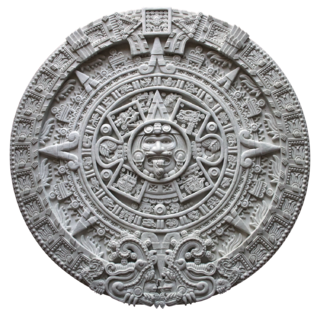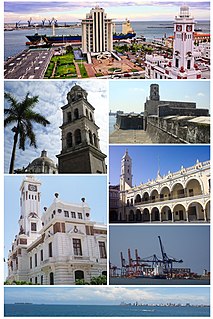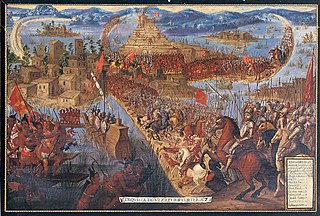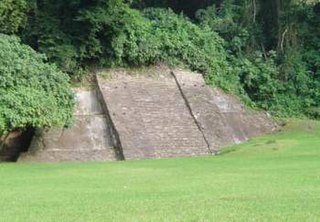
Cuitláhuac or Cuitláhuac was the 10th tlatoani (ruler) of the Aztec city of Tenochtitlan for 80 days during the year Two Flint (1520). He is credited with leading the Mexica resistance to the Spanish invasion, following the death of his kinsman Moctezuma II.

Tenochtitlan, also known as Mexica-Tenochtitlan, was a large Mexica altepetl in what is now the historic center of Mexico City. The exact date of the founding of the city is unclear. The date 13 March 1325 was chosen in 1925 to celebrate the 600th anniversary of the city. The city was built on an island in what was then Lake Texcoco in the Valley of Mexico. The city was the capital of the expanding Aztec Empire in the 15th century until it was captured by the Spanish in 1521.

The Aztecs were a Mesoamerican culture that flourished in central Mexico in the post-classic period from 1300 to 1521. The Aztec peoples included different ethnic groups of central Mexico, particularly those groups who spoke the Nahuatl language and who dominated large parts of Mesoamerica from the 14th to the 16th centuries. Aztec culture was organized into city-states (altepetl), some of which joined to form alliances, political confederations, or empires. The Aztec Empire was a confederation of three city-states established in 1427: Tenochtitlan, city-state of the Mexica or Tenochca; Texcoco; and Tlacopan, previously part of the Tepanec empire, whose dominant power was Azcapotzalco. Although the term Aztecs is often narrowly restricted to the Mexica of Tenochtitlan, it is also broadly used to refer to Nahua polities or peoples of central Mexico in the prehispanic era, as well as the Spanish colonial era (1521–1821). The definitions of Aztec and Aztecs have long been the topic of scholarly discussion ever since German scientist Alexander von Humboldt established its common usage in the early nineteenth century.

Veracruz, formally Veracruz de Ignacio de la Llave, officially the Free and Sovereign State of Veracruz de Ignacio de la Llave, is one of the 32 states which comprise the Federal Entities of Mexico. It is divided in 212 municipalities and its capital city is Xalapa-Enríquez.

The Viceroyalty of New Spain was an integral territorial entity of the Spanish Empire, established by Habsburg Spain during the Spanish colonization of the Americas. It covered a huge area that included territories in North America, South America, Asia, and Oceania. It originated in 1521 after the fall of Tenochtitlan, the main event of the Spanish conquest, which did not properly end until much later, as its territory continued to grow to the north. It was officially created on 18 August 1521 as a Kingdom, the first of four viceroyalties Spain created in the Americas. Its first viceroy was Antonio de Mendoza y Pacheco, and the capital of the kingdom was Mexico City, established on the ancient Tenochtitlan.

The Nahuas are a group of indigenous people of Mexico and El Salvador, historically also present in parts of Guatemala, Honduras, and Nicaragua. The Nahuas comprise the largest indigenous group in Mexico and second largest group in El Salvador. The Aztec and Toltec cultures were of Nahua ethnicity.

Mesoamerican chronology divides the history of prehispanic Mesoamerica into several periods: the Paleo-Indian, the Archaic, the Preclassic or Formative (2500 BCE – 250 CE), the Classic (250–900 CE), and the Postclassic (900–1521 CE), Colonial (1521–1821), and Postcolonial (1821–present).

Veracruz, officially known as Heroica Veracruz, is a major port city and municipality on the Gulf of Mexico in the Mexican state of Veracruz. The city is located along the coast in the central part of the state, 90 km (56 mi) southeast of the state capital Xalapa along Federal Highway 140.

The Aztec Empire, or the Triple Alliance, was an alliance of three Nahua altepetl city-states: Mexico-Tenochtitlan, Texcoco, and Tlacopan. These three city-states ruled the area in and around the Valley of Mexico from 1428 until the combined forces of the Spanish conquistadores and their native allies under Hernán Cortés defeated them in 1521.

The Spanish conquest of the Aztec Empire, also known as the Conquest of Mexico (1519–21), was one of the primary events in the Spanish colonization of the Americas. There are multiple 16th-century narratives of the events by Spanish conquerors, their indigenous allies, and the defeated Aztecs. It was not solely a contest between a small contingent of Spaniards defeating the Aztec Empire but rather the creation of a coalition of Spanish invaders with tributaries to the Aztecs, and most especially the Aztecs' indigenous enemies and rivals. They combined forces to defeat the Mexica of Tenochtitlan over a two-year period. For the Spanish, the expedition to Mexico was part of a project of Spanish colonization of the New World after twenty-five years of permanent Spanish settlement and further exploration in the Caribbean.

The Mexica, or Mexicas, are a Nahuatl-speaking indigenous people of the Valley of Mexico who were the rulers of the Aztec Empire. They were the last Nahua-speaking immigrants to enter the Basin of Mexico after the Toltec decline. This group was also known as the Culhua-Mexica in recognition of its kinship alliance with the neighboring Culhua, descendants of the revered Toltecs, who occupied the Toltec capital of Tula from the tenth through twelfth centuries. The Mexica were additionally referred to as the "Tenochca", a term associated with the name of their altepetl (city-state), Tenochtitlan, and Tenochtitlan's founding leader, Tenoch. The Mexica established Mexico Tenochtitlan, a settlement on an island in Lake Texcoco. A dissident group in Mexico-Tenochtitlan separated and founded the settlement of Mexico-Tlatelolco with its own dynastic lineage.

Cuyuxquihui is an archaeological site located in the Tecolutla valley of Veracruz, Mexico, in the region of the Totonac culture, about 22 kilometres (14 mi) southeast of El Tajín or 5 kilometres (3.1 mi) southeast of Paso de Correo.

Tlatelolco was a prehispanic altepetl or city-state, in the Valley of Mexico. Its inhabitants were known as Tlatelolca. The Tlatelolca were a part of the Mexica, a Nahuatl-speaking people who arrived in what is now central Mexico in the 13th century. The Mexica settled on an island in Lake Texcoco, founding the altepetl of Mexico-Tenochtitlan on the southern portion of the island. In 1337, a group of dissident Mexica broke away from the Tenochca leadership in Tenochtitlan and founded Mexico-Tlatelolco on the northern portion of the island. Tenochtitlan was closely tied with its sister city, which was largely dependent on the market of Tlatelolco, the most important site of commerce in the area.

Castillo de Teayo is a mesoamerican Prehispanic archeological site and Mesoamerican pyramid, located in the La Huasteca region in northern Veracruz, Mexico. The main access to the site is via Federal Highway 130 México-Tuxpan up to the city of Teayo, it belongs to the Huastec culture and it is estimated it was inhabited between the 10th and 12th centuries.
Poder Mexica is a professional wrestling stable currently working for Consejo Mundial de Lucha Libre (CMLL). The stable was founded in December 2008 and consists of Sangre Azteca and Misterioso, Jr.. Black Warrior and Dragón Rojo, Jr. were originally members of the group, but left in the fall of 2009 and 2010 respectively.

Balcón de Montezuma, also known as "Balcon del Chiue" is an archaeological site located at the Alta Cumbre ejido, some 18 kilometres (11.2 mi) south of Ciudad Victoria, in the state of Tamaulipas, México. It is situated about one kilometer north of Highway 101, towards San Luis Potosí.

The Estadio Jesús Martínez "Palillo" is a multi-use stadium located in the Magdalena Mixhuca Sports City in Mexico City. The stadium has a capacity of 6,000 people.

Citlaltépetl is a municipality in the Mexican state of Veracruz, located 223 kilometres (139 mi) northwest of the state capital of Xalapa and 99 kilometres (62 mi) south of the city of Tampico, Tamaulipas.

Tomatlán is a municipality in the Mexican state of Veracruz, located 58 kilometres (36 mi) south of the state capital of Xalapa.

The Mexicas, also called Mexicas LFA or Mexicas CDMX, are a semi-professional American football team based in Mexico City (CDMX), Mexico. The team was founded in 2015 with the name of Eagles, and is one the four charter members of the Liga de Fútbol Americano Profesional, the top American football league in Mexico. The Mexicas compete in the Central Division of the LFA and play their home games at the Casco de Santo Tomás. The Mexicas are the reigning champions of the LFA, winning Tazón México III in 2018.



















